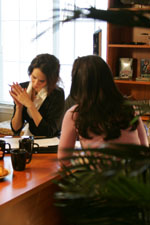How To Sell Wine To Your Guests
For many restaurants, wine sales are a primary component of the bottom line. They typically represent a 30-40 per cent cost on revenue and guests who order a bottle of wine tend to order better entrees and enjoy their experience more. Generally speaking, restaurants who don’t emphasize wine sales can boost revenues with just a slight refocus on wine. Restaurants that carry wine but don’t highlight it with a solid list and an educated staff are overlooking a proven source of income. This can often be remedied with just a slight readjustment and a little bit of effort.
The first step to wine-selling success is a good list. Effective wine lists usually represent a cross-section along varieties, regions and price points. In this way, a guest can always find the bottle he or she is looking for. However, overemphasizing certain types of wines is a good idea when creating pairings for a menu. For example, an Italian restaurant should offer a heavy dose of brunellos and an American chophouse should have its share of bold Cabernets.
Good wine lists will compliment a strong selection of top-sellers with a few tasty cult wines that are difficult to find. Creating this diversity requires either an extensive knowledge of wines or a good relationship with wine vendors. Regardless, of an operator’s knowledge of wines or his or her tastes, it is always a good idea to get to know your vendors. Never be married to individual vendors and be open-minded to their wisdom. In many cases, vendors can bring knowledge discerned from other restaurants and help your servers gain merchandising tips.
Updating a wine list occasionally helps your staff expose guests to new labels while infusing your list with variety and energy. You can boost the results of new wines by offering them at a discount in their first week in your store. In this case, servers can merchandise them by saying, “We just got in a new California merlot that’s excellent….” Many operators also attract attention to their lists by offering them at half off on a slow night, such as a Sunday or early weeknight. Half-off wine nights have become so popular in recent years that many restaurant-goers have chosen to only dine out on those nights.
Ultimately, it is your service staff who is selling your list. Therefore, they must be equipped to represent it with expertise and enthusiasm. Hiring wine savvy servers is a must in upscale restaurants. Servers who see their peers putting big-dollar wines on their tables in neighboring sections grow motivated to learn wine on their own. Contests are another great way to cultivate wine sales. Contests can involve entire lists or individual wines you want moved off your shelves. Finally, good wine tastings are usually a necessary component of effective sales. They offer the advantages of letting your servers develop their knowledge while deciding what they like and don’t like. A server who has tried a juicy California merlot in a tasting, is backed by a decent price point and motivated by a contest to sell it is far more likely to be successful.
Finally, your servers should have a few strategies up their sleeves. One very effective strategy is profiling the merits of an expensive bottle, and then comparing a less expensive one favorably. In this case, the server should let the guest recognize the price difference and make a decision. Another strategy is to merchandise a bottle that he or she can offer at a discounted rate specifically for a guest for some random reason: i.e. the guest’s tenth visit, the color of his hair or the cut of his jib. The reason is secondary to the discount.
Servers should always have 2-4 wines picked out from each variety represented on the list that he or she masters. Those wines should be at varying price points. This should be mandatory for all your servers, so that an operator should be able to walk up to any server and ask which wines he or she is going to sell today. These steps all represent a minor effort that make a huge difference.
